Core V.3 - High level design
This document describes the design of the new Core, version 3. A high level design has been made and the implementation has started but has not been finished.
The big picture
The idea behind Core V.3 is to decrease the complexity of the Core and increase maintainability and to make it more easy to add new functionality. Core V.2 is today a highly complex software where it can take up to a week for a developer to successfully add new functionality that includes communication from the API, through Core, to the Server and then back. With Core V.3 this should be straight forward and only take less than a day, depending on the extent of the functionality to add of course. The goal of decreasing complexity would be reached by decreasing the amount of threads that Core are using, from around 13, down to a few threads. Also to avoid sending serialized messages between the different modules and instead communicate in a more direct way between the modules would help to decrease the complexity.
The image below shows the high level blocks of the Core V.3 design.
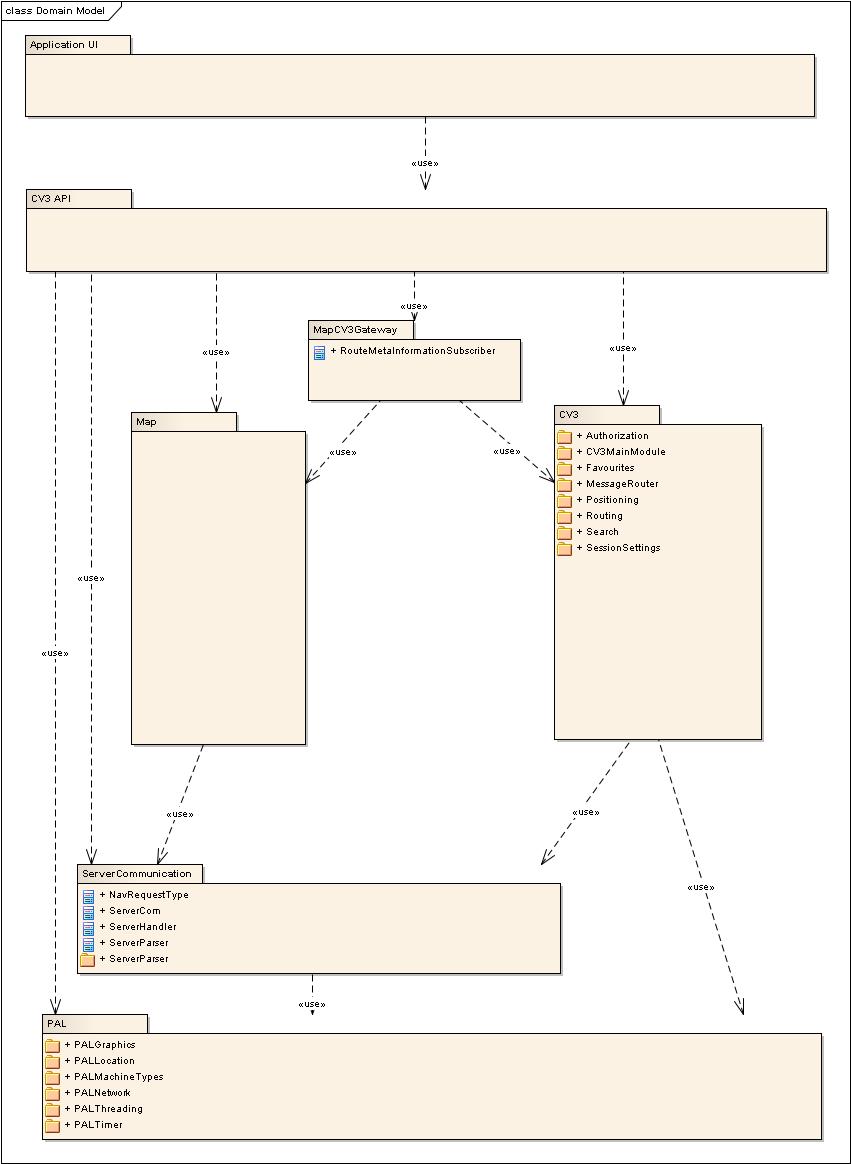
As you can see in the picture, Core V.3 consists of six parts, the application UI excluded.
PAL
The lowest part of Core V.3 is PAL, the Platform Abstraction Layer. It consists of all platform dependent code that is needed for Core V.3 to function. For example threads and GPS communication will be handled here. The rest of the Core V.3 will communicate with PAL using defined interfaces in PAL.
Server Communication
The block contains all functionality for handling the communication with the servers, creating the messages to send and parsing replies in a way that Core V.3 can understand. It also uses the network functionality in PAL to handle the physical connection.
Map
This would be the Map used in Core V.2 but accommodated to fit in Core V.3 of course, using the new PAL.
CV3
The heart of the Core V.3 library, containing the functionality for handling routing, searching, positioning and so on. The basic functionality would be the same as in Core V.2, but, as mentioned above, with decreased complexity making it more easy to add new modules and functionality. The number of threads would be reduced to one in the normal scenario, but be able to run heavy tasks in separate threads.
MapCV3Gateway
The idea behind this block is that it should work like a gateway between the map component and CV3, instead of communicating directly into each other. The gateway can be used to send route data from CV3 to the map and the information can be used to interact with the map. For example used to draw turn images in the map using the route data. All information sharing between CV3 and the map shall go through this gateway. Also this entity will probably have more knowledge about the map and CV3 than the API has.
CV3 API
The API should contain the same functionality as Core V.2 LBS API does, and in the long run new functionality will be added, of course. The interfaces used by applications would, as much as possible, be similar to Core V.2 LBS API, but simplified if possible. The implementation of the API itself would be simplified and easier to maintain compared to Core V.2 API implementation, this would be a natural step due to the improvements in Core V.3.
It is all in the details
This chapter will explain how Core V.3 are supposed to work in a more detailed way.
CV3
As mentioned above, CV3 is the heart of the Core V.3 library, containing the logic for the core functionality, as navigation, searching and positioning. It includes the modules shown in the picture below.
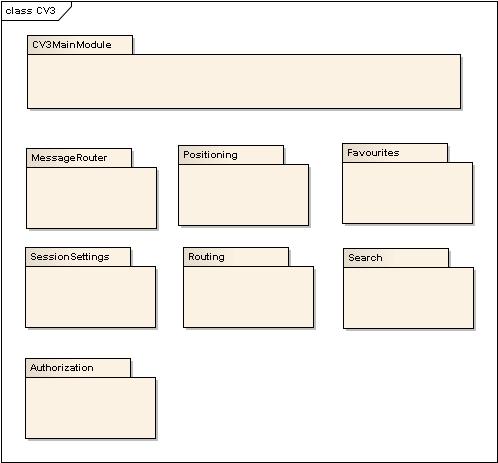
CV3MainModuleContains the main functionality for CV3, start up, close down etc.MessageRouterHandling how messages are sent within CV3, making sure the correct receiver receives the message the sender has sent. Handles messages sent within CV3 as well as messages sent from the API and to and from the server.AuthorizationHandles authorization of the user, making sure the user is entitled to use the services at all, and also differs between authorization levels so the user only can do what he/she has permission to.SessionSettingsHandles the settings for the user, this can be both settings set by the user and also settings used by CV3. Also includes persistent storage of the settings.PositioningHandles the positioning of the user, using the GPS communication implemented in PAL.RoutingHandles the routing functionality in CV3, contains functions for requesting routes and route information etc.FavouritesHandles the user’s favourite destinations, syncing, adding and so on.SearchHandles searching.
When implementation of Core V.3 is done it will probably contain more modules.
Module communication
The idea is that the modules should work rather independent from each other, this means that they should not call directly into each others public functions. This way it will be possible to choose not to include some modules in a specific build if they are not needed. Still, some modules could have the need to retrieve information from an other modules. E.g. the routing module could have the need of retrieving position updates from the positioning/location module obviously.
This is solved by using predefined interfaces. The image below shows the class diagram over how the communication should be handled:
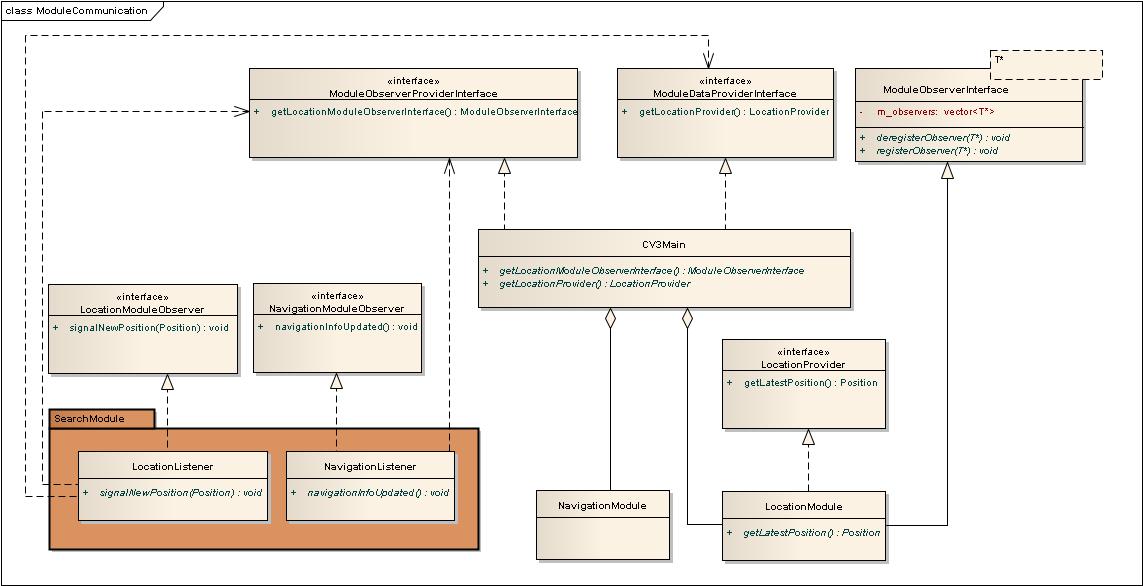
A module that has data to share should implement the ModuleObserverInterface. Through this interface are other modules able to register them self as observers. This is done by retrieving the ModuleObserverInterface for the module to ask for data from the ModuleObserverInterfaceProvider and then register as an observer. The ModuleObserverInterfaceProvider will contain all module specific interfaces that are available.
The module that has data to share should also provide an interface for listening modules to implement. This interface are then used by the module to share the data when needed. E.g. the location module provides an interface called LocationModuleObserver that the search module implements to listen for position updates.
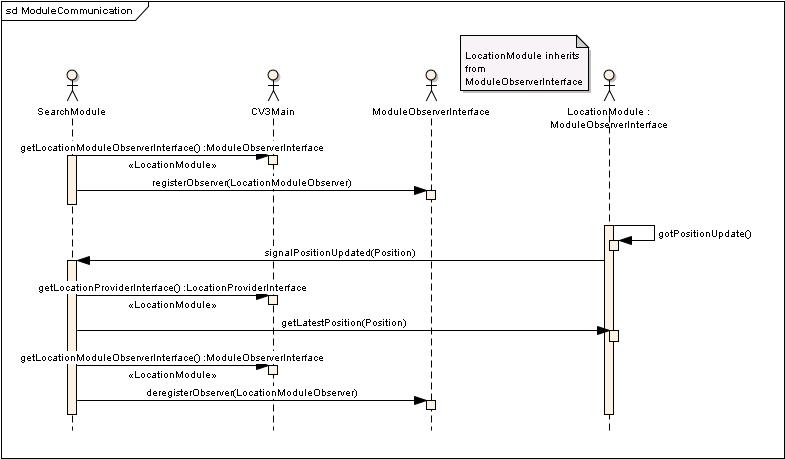 ##### Message Router
##### Message Router
The message router module is used by the other modules to send and receive data from the server communication block or the API. It consists of a MessageRouter and the MessageDispatcher and also a number of interfaces used by other modules to receive and send messages.
The MessageDispatcher is used by modules to send messages using three interfaces, the NGPMessageSender (sends NGP messages to the server), APIMessageSender (sends messages to the API) and InternalMessageSender (sends internal CV3 messages).
The MessageRouter receives messages addressed to CV3 and make sure the correct module gets the message. The MessageRouter is not known to anyone outside of CV3, instead are interfaces used for this purpose. For example ServerHandler only knows about the NGPMessageReceiver which it uses to transport incoming messages from the server to the MessageRouter.

Server Communication
Since Core V.3 is part of a client-server solution it is dependent of retrieving data from the server. A independent block in Core V.3 handles the server communication. It is independent from CV3 due to the Map block is also in need for a server connection in order to download map data. By being independent from CV3 it is not needed that CV3 is running for the Map component to download data.
The ServerHandler is the center of the server communication. It receives messages from CV3 and the map, through the NGPMessageSender interface, and sends the messages to the server. When the reply is received from the server the ServerHandler make sure the correct recipient receives the reply. The ServerHandler uses ConnectionManager for access to a proper network connection.
Connection Manager
The ConnectionManager is the entity that handles all network connections, not just the connections to the server providing map data, route data and search data. It can also be used for handle connections to third party data providers. It simply handles the connection to a provided server. Further more the ConnectionManager differentiates between different kind of bearers, e.g WiFi and PDP, but as standard it gives you the best network bearer available.
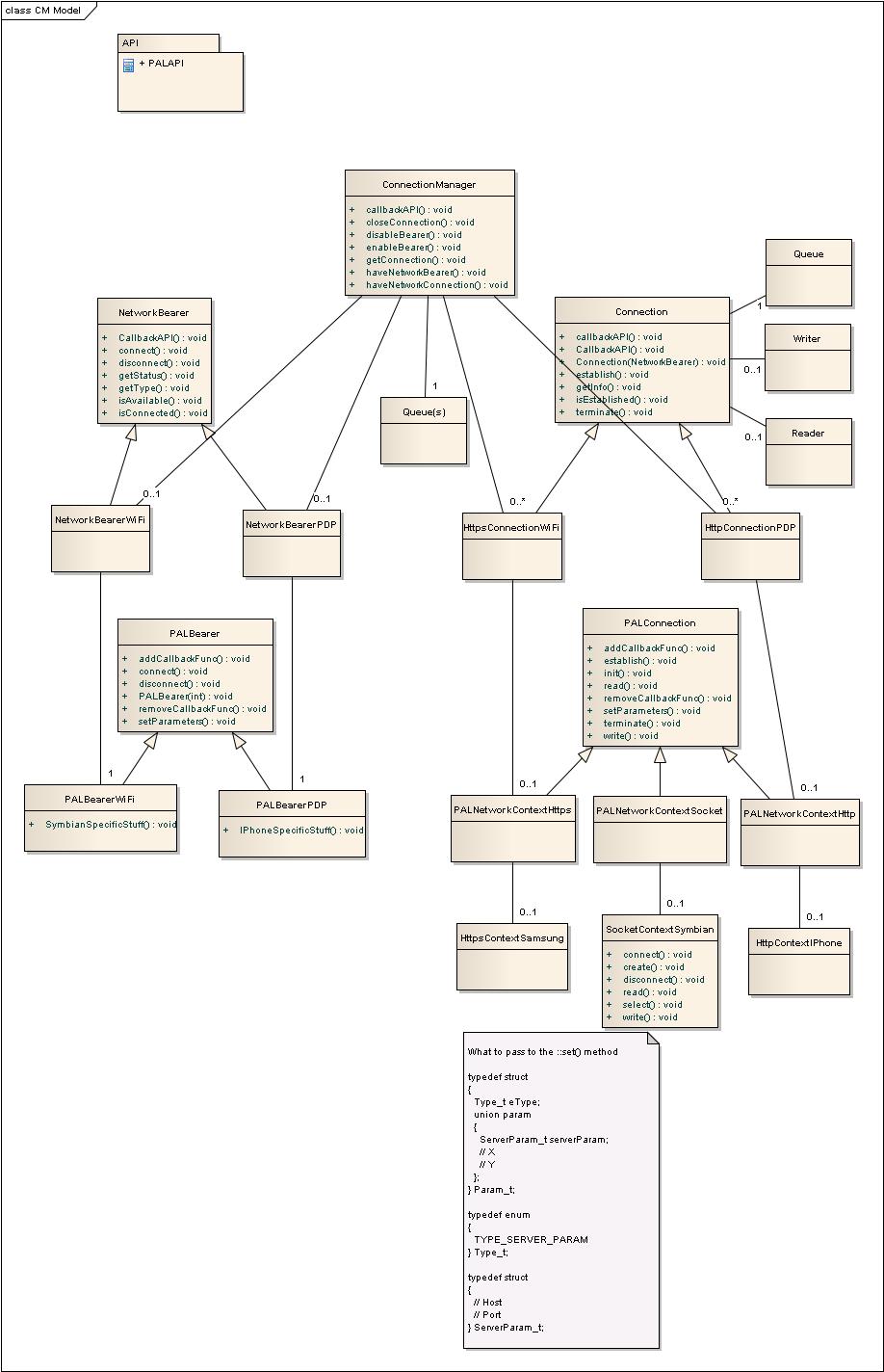
As you can see in the image above ConnectionManager uses network implementations in PAL to handle the connections since that most platform has its own network implementations.
Platform Abstraction Layer, PAL
As mentioned before the PAL consists of unified interfaces for platform dependent implementations. This way CV3, the map component and the server communication does not need to bother about different platform limitations and instead just use the platform independent interfaces. PAL today exists of:
PALLocationHandles GPS communication.PALThreadingHandles threads on different platforms. POSIX is used if possible.PALGraphicsProvides an interface for graphic operations.PALTimeUtilsHandles operations for time functions.PALMachineTypesHandles machine specific types.PALNetwork,PALConnection,PALBearer,PALSocketandPALNetworkInfoHandles network specific implemenations.
Core V.3 LBS API
The basic idea is that Core V.3 shall be implemented in a way that makes it possible to implement the API in not just C++, but also in C and JNI. For start the old LBS API used in Core V.2 should be reused and fitted into Core V.3, that will make it possible for old clients built on Core V.2 LBS API to easily adapt to Core V.3 instead. By implementing a JNI API the Core V.3 should work on Android for example.